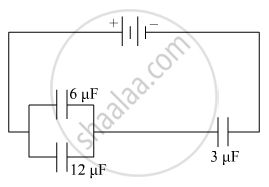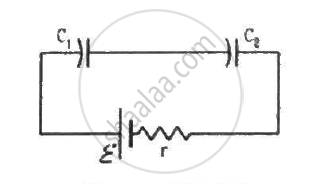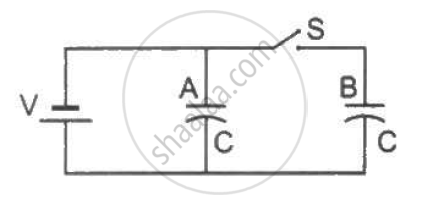Advertisements
Advertisements
प्रश्न
A capacitor of capacitance C is given a charge Q. At t = 0, it is connected to an uncharged capacitor of equal capacitance through a resistance R. Find the charge on the second capacitor as a function of time.
उत्तर
Given:-
Initial charge on first capacitor = Q
Let q be the charge on the second capacitor after time t.
According to the principle of conservation of charge, charge on the first capacitor after time t = Q - q.
Let V1 be the potential difference across the first capacitor and V2 be the potential difference across the second capacitor after time t. Then,
\[V_1 = \frac{Q - q}{C} \]
\[ V_2 = \frac{q}{C}\]
\[ \Rightarrow V_1 - V_2 = \frac{Q - q}{C} - \frac{q}{C}\]
\[ = \frac{Q - 2q}{C}\]
The current through the circuit after time t,
\[i = \frac{V_1 - V_2}{R} = \frac{dq}{dt}\]
\[ \Rightarrow \frac{Q - 2q}{CR} = \frac{dq}{dt}\]
\[ \Rightarrow \frac{dq}{Q - 2q} = \frac{1}{RC}dt\]
\[ \Rightarrow \frac{dq}{Q - 2q} = \frac{1}{RC}dt\]
Integrating both sides within the limits time =0 to t and charge on the second capacitor varying from q=0 to q, we get:-
\[\frac{1}{2} \left[ \ln \left( Q - 2q \right) - \ln Q \right] = \frac{- 1t}{RC}\]
\[\ln \frac{Q - 2q}{Q} = \frac{- 2t}{RC}\]
\[Q - 2q = Q e^{- \frac{2t}{RC}} \]
\[2q = Q\left( 1 - e^{- \frac{2t}{RC}} \right)\]
\[q = \frac{Q}{2}\left\{ 1 - e^{- \frac{2t}{RC}} \right\}\]
APPEARS IN
संबंधित प्रश्न
In the following arrangement of capacitors, the energy stored in the 6 µF capacitor is E. Find the value of the following :
(i) Energy stored in 12 µF capacitor.
(ii) Energy stored in 3 µF capacitor.
(iii) Total energy drawn from the battery.

Find the ratio of energy stored in the two configurations if they are both connected to the same source.
A capacitor C1 of capacitance 1 μF and a capacitor C2 of capacitance 2 μF are separately charged by a common battery for a long time. The two capacitors are then separately discharged through equal resistors. Both the discharge circuits are connected at t = 0.
(a) The current in each of the two discharging circuits is zero at t = 0.
(b) The currents in the two discharging circuits at t = 0 are equal but not zero.
(c) The currents in the two discharging circuits at t = 0 are unequal.
(d) C1 loses 50% of its initial charge sooner than C2 loses 50% of its initial charge.
A 100 μF capacitor is joined to a 24 V battery through a 1.0 MΩ resistor. Plot qualitative graphs (a) between current and time for the first 10 minutes and (b) between charge and time for the same period.
Two capacitors of capacitances 4⋅0 µF and 6⋅0 µF are connected in series with a battery of 20 V. Find the energy supplied by the battery.
Consider the situation shown in figure. The switch is closed at t = 0 when the capacitors are uncharged. Find the charge on the capacitor C1 as a function of time t.

Figure shows two identical parallel plate capacitors connected to a battery through a switch S. Initially, the switch is closed so that the capacitors are completely charged. The switch is now opened and the free space between the plates of the capacitors is filled with a dielectric of dielectric constant 3. Find the ratio of the initial total energy stored in the capacitors to the final total energy stored.

Answer the following question.
Obtain the expression for the energy stored in a capacitor connected across a dc battery. Hence define energy density of the capacitor
If the p. d. across a capacitor is increased from 10 V to 30 V, then the energy stored with the capacitor ____________.
A capacitor is charged by a battery and energy stored is 'U'. Now the battery is removed and the distance between plates is increased to four times. The energy stored becomes ______.
A 2µF capacitor is charge to 100 volt and then its plate are connected by a conducting wire. The heat produced is:-
A parallel plate capacitor has a uniform electric field ‘`vec "E"`’ in the space between the plates. If the distance between the plates is ‘d’ and the area of each plate is ‘A’, the energy stored in the capacitor is ______
(ε0 = permittivity of free space)
Prove that, if an insulated, uncharged conductor is placed near a charged conductor and no other conductors are present, the uncharged body must be intermediate in potential between that of the charged body and that of infinity.
A parallel plate capacitor (A) of capacitance C is charged by a battery to voltage V. The battery is disconnected and an uncharged capacitor (B) of capacitance 2C is connected across A. Find the ratio of total electrostatic energy stored in A and B finally and that stored in A initially.
In a capacitor of capacitance 20 µF, the distance between the plates is 2 mm. If a dielectric slab of width 1 mm and dielectric constant 2 is inserted between the plates, what is the new capacitance?
